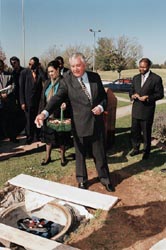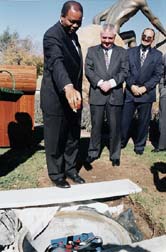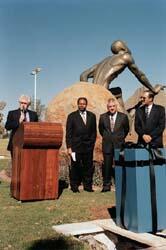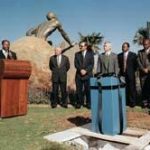Time Capsule
On 25 May 1999 a time capsule was buried close to the Energy Statue at Megawatt Park, Eskom’s Head Office in Sandton. The capsule is to be opened on the occasion of Eskom’s 100th anniversary. That anniversary will be on 1 March 2023. A video recording of the ceremony is stored in the Megawatt Park Information Centre.



Our sealed time capsule is simply a container that holds records and objects. It is being used to store for posterity a selection of material that is representative of life in our organisation at the present time. We intend that the capsule remain in this site until it is unearthed by the Eskomites of the year 2023. That is the year in which Eskom will celebrate 100 years of existence: its centenary. The contents of the capsule will create awareness of past and recent achievements. The time capsule is, in fact, a “snapshot of today” and our gift to our colleagues of the future. I hope that it inspires future Eskomites. And I hope that the future Eskomites adopt this practice, preserve key features of history and replace the capsule for succeeding generations of Eskom. This time capsule will be registered with the International Time Capsule Society in Atlanta, USA.
This society:
maintains a registry of all known time capsule
it encourages the study of the history, variety and motivation behind time capsule projects.
it educates the general public and the academic community concerning the value of time capsules.
Our short programme this morning will be:
Our Chairman, Mr. Reuel Khoza, will address us.
After Mr. Khoza’s address the time capsule will be lowered into the site.
Our ceremony is concluded with our Chairman and members of the Management Review Committee scattering rose petals on the capsule. This is a symbolic tribute to past and future Eskom achievers. After we depart, a concrete cover bearing a dedication plate will be cast over the capsule.


The Chairman’s Address
Eskom is a part of Africa. Its roots lie deep in the African soil. For more than 75 years, Eskom has laboured in the African sun. The coal we use in our power stations has been part of Africa for thousands of years. The very reason for Eskom’s existence is intimately bound up with Africa. Eskom’s destiny is Africa’s destiny. All our labour, all our energy, is directed at bringing power to this part of the globe.
There should be no doubt in anyone’s mind about Eskom’s origins and its credentials. There should also be no doubt about Eskom’s contribution to this most ancient and noble continent. More than anyone else, Eskom has been instrumental in bringing the wonderful benefits of electrical power to Africa. We currently produce in excess of 50% of all electricity consumed on the African continent. Our product is still a cause for awe and amazement to many.
At this historical conjuncture, Eskom stands at a crossroads. Thus far we have followed a path that has been fairly straight and well defined. Now we are faced with various possibilities. On the one hand, we could maintain our narrow focus on South Africa and the meeting of its electricity needs. In this, we have shown ourselves to be exceptional performers. By the end of the year we will have met our commitment to electrify one and three-quarter million homes in 5 years since we committed to this particular initiative. In the remote rural areas, solar systems are being installed at a great rate. Our expertise is recognised world-wide.
On the other hand, we could look further afield. Globalisation is a huge force sweeping the entire world. The big international players would love to establish themselves in Africa, which has huge potential for development. Already other organisations have offices in Johannesburg, so the competition is knocking at our door – it is no longer theoretical. If we ignore this trend and fail to prepare for it, we will be swallowed up by the great multinational corporations.
So as we stand on the threshold of the new millennium, our path seems fairly clear. We must meet the challenge. While we keep our roots in this part of Africa, our gaze must cover the continent. But we must know what our ultimate objective is, and keep our sights firmly fixed on that objective, lest we lose our way. To that end, we have formulated a new statement of our strategic intent, that reads as follows:
“To be a pre-eminent African energy and related services business, with global stature.”
This statement reflects dynamic work in progress and could be refined further as we consult our colleagues and stakeholders. With this strategic intent in mind, we have restructured the organisation into two main divisions. One of them, Eskom Enterprises, has been relieved of any regulatory requirements and is well positioned to take our influence into Africa and beyond. Soon, the name of Eskom will be known in many distant places and our expertise will enhance standards of living for people that we may never even get to meet or know.
Archaeologists tell us that Africa is the cradle of mankind, and we choose to believe this. Our home is truly the most ancient of continents. Now we have the responsibility of making it the most modern, the most progressive. As men and women of Africa, we must ensure that we lead the way for others to follow. And as we witness the internment of the capsule, we are symbolically handing a message across a divide of time to our successors in the 21st century. By the time this capsule is opened in the year 2023, many of us may have passed on (not literally, in terms of dying) but in terms of taking advantage of having passed over our great responsibility to a new generation. We will, no more, have the opportunity to direct this organisation or influence this industry.
Let us then ensure that while we are here, we make a difference. Let us make the most of our energies and be sure that the future of our country and our continent is a very glorious one.
Thank you very much.
Eskom News Release, 25 May 1999
ESKOM BURIES THE PAST FOR THE FUTURE
Eskom’s senior management gathered at its Megawatt Park headquarters today (Tuesday 25 May 1999) to bury a ‘time capsule’. The capsule, a square stainless steel container to preserve Eskom artifacts, memorabilia and documents relevant to its past, was interred at a site near the main entrance to the building. It is intended for opening in 2023, Eskom’s centenary year. The burial site will be registered with the International Time Capsule Society in Atlanta, USA.
Speaking at the event, Eskom chairman Reuel Khoza said Eskom was inextricably bound up with Africa. Its roots were in the continent but its new strategic intent vision made it clear that Eskom had global aspirations. Eskom Enterprises, a product of the organisation’s recent restructuring, was ideally positioned to extend Eskom’s influence into the rest of the continent and beyond.
Eskom has recently opened an office in Kampala, the Ugandan capital, to spearhead Eskom’s forays into Africa. Eskom Enterprises director, Duncan Mbonyana, will head up the operation. Typical of the projects to be launched is Motraco, a joint venture between Eskom and its counterparts in Swaziland and Mozambique. The partnership agreements for Motraco were signed in Maputo on 20 May.
With far-reaching changes for the electricity supply industry being discussed in parliament, no-one can be certain what Eskom will look like in 2023. The distribution function could reside in a separate organisation and the power stations could be privatised, competitive entities. So it seems possible that 1999 is the most appropriate time to compile a collection of artifacts and documents giving future generations a glimpse into Eskom’s past, in the 20th century.
TIME CAPSULE CONTENTS
- Letter from the Chairman and the Chief Executive to the Eskomites of the year 2023
- The Annual Report for 1997 and 1998
- Copies of the videos of the 75th Anniversary luncheon, Chairman’s Awards and any footage captured at Eskom sites. The video entitled the Eskom Heritage
- Copies of all videos covering our history. The 75th Anniversary logo
- Copies of internal publications carrying information concerning the 75th Anniversary
- A sample of the 75th Anniversary banner, poster and t-shirt
- Poster, banner and t-shirt showing Eskom’s support of the Year of Science and Technology
- A copy of the 25th Anniversary publication, 50th anniversary publication, Power 80 and “75 YEARS SERVING THE NATION”.
- Copies of all videos and photographs of all achievements in 1998
- List of patents held by Eskom
- Videos of the Eskom choir
- Plan showing the current electricity grid and proposed expansion projects
- An organigram of Eskom’s Management Review Committee
- A sample of the first pre-paid meter
- Illustration of current corporate gifts
- A sample of an Eskom bond
- Major news releases of 1998
- Letter from employees with predictions for 2023
- All the big news stories of the year
- Aerial photographs of significant Eskom buildings
- A list of our Top 40 suppliers
- A list of our Top 40 customers
- A copy of the Eskom Dictionary for the Electricity Supply Industry
- A copy of Generation’s performance poster when 90:7:3 was reached
- A letter from the Generation Executive team wishing the operators of the future the best with their performance
- A sample of a Managers Awards certificate and medal
- A letter from the Heritage manager explaining the purpose of the capsule
- Technical information on the time capsule
- Samples of corporate advertisements
- A list of Small, Medium and Micro-enterprises (SMMEs) supplying Eskom
- Technical information of various Eskom power stations
- A CD-ROM consisting images of power stations and various personalities
- Time Magazine’s special report on South Africa
- A selection of current newspapers
